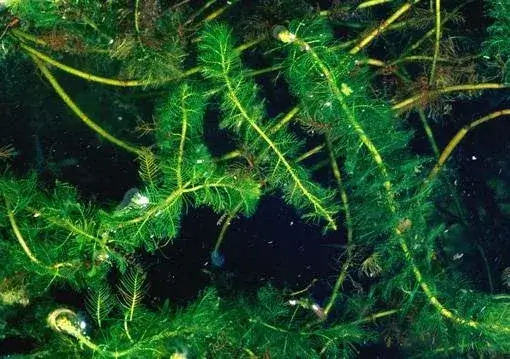
Eurasian watermilfoil, Myriophyllum spicatum L., (Fig. 1) is a submersed aquatic plant that has become a major aquatic invader across much of North America. Plants are rooted at the lake bottom and grow rapidly creating dense beds and canopies (Fig. 2). Milfoil typically grows in water 1 to 4 meters (3.2 to 13 feet) deep, but has been found in water as deep as 10 m (32.8 ft). Stem densities can exceed 300/m2 (359/yd2) in shallow water. Conventional control efforts such as mechanical harvesting have been unsuccessful in providing more than short-term relief. The use of herbicides have been found to suppress regrowth for six weeks to a year but have considerable negative effects on non-target organisms (e.g., mortality of native macrophytes, fish kills, increased algal growth, and contamination of public water supplies). Mechanical harvesting can result in short term localized population reductions but these methods are labor intensive and costly; continued relief must be supported by long-term mechanical intervention. Further, since harvesting inevitably results in the release of milfoil fragments, the harvesting process itself may be responsible for spreading the plant to uninfested areas.
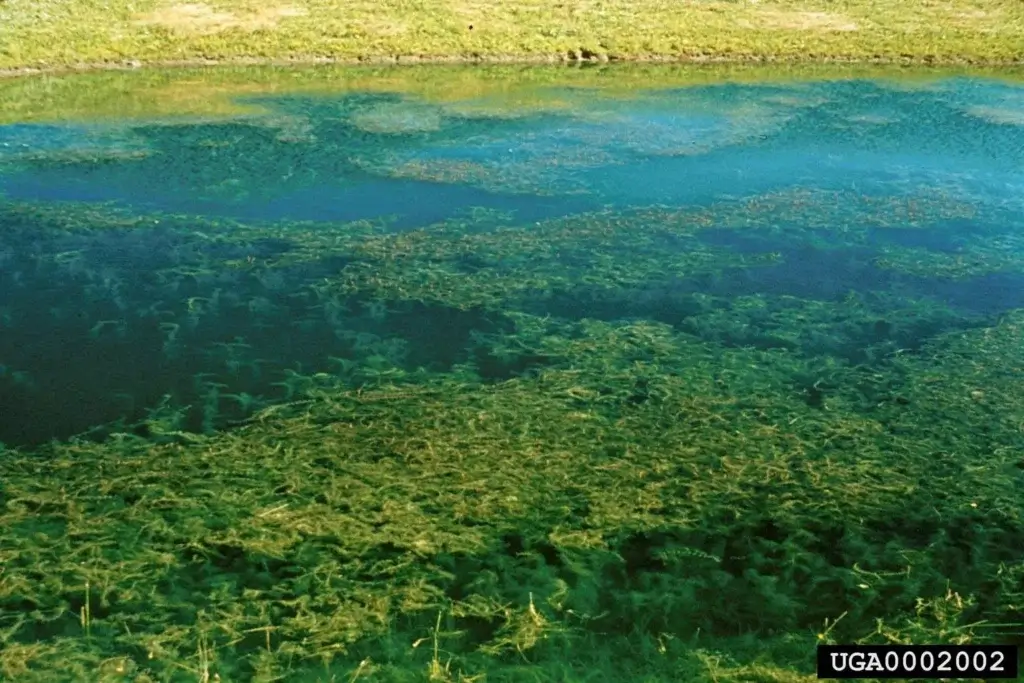

Ecologic damage. Introduction of Eurasian watermilfoil can result in native macrophyte diversity and abundance declines. Eurasian watermilfoil beds form dense canopies at the water surface thereby reducing light penetration early in the season before native macrophytes have reached their full growth, shading them out and slowing/reducing growth potential. Eurasian watermilfoil beds, as a result of the reduction in native plants, have been found to contain significantly fewer macroinvertebrates (including benthic invertebrates) and a concomitantly lower abundance of native fish species. Milfoil-infested lakes tend to have reduced fish spawning areas and lowered fish growth rates. Native waterfowl in the Great Lakes have been found to avoid foraging for food in beds of Eurasian watermilfoil.
Economic damage. The negative impacts on wildlife and fish populations in waterbodies with high densities of Eurasian watermilfoil and the difficulty of motorboating and swimming in infested areas result in recreation-oriented financial losses and the depreciation of shoreline property values (accompanied by a loss of real estate taxes to local economies). It is estimated that milfoil control efforts have cost the United States millions of dollars per year nationwide. Annual control costs in New York state easily exceed half a million dollars per year.

Eurasian watermilfoil belongs to the watermilfoil family, Haloragaceae, which has two genera in the eastern United States, Myriophyllum L. (10 species, the watermilfoils) and Proserpinaca L. (two species, the so-called mermaid-weeds). All species are submersed herbs inhabiting quiet waters or rooted on muddy shores; all have many finely divided leaves. The species are very similar, resulting in difficulty in identification using only individual specimens or ones without flowers. This has lead to a debate about whether reports of infestations prior to 1940 are actually misidentifications of native species. Myriophyllum spicatum is variable in appearance with long stems, and 12 to 21 leaflet pairs which are limp when out of water. Native M. sibiricum has 5 to 10 leaflet pairs which remain rigid when out of the water. Flowers are arranged on emersed spikes which bear whorls of female flowers basally and whorls of male flowers apically. Female flowers produce four small (2 to 3 mm, 0.08 to 0.16 inch) nutlike fruits .

Eurasian watermilfoil inhabits ponds and lakes that vary from deep (greater than 100 m, 328 feet) to very shallow (less than a meter, or yard). Waters inhabited may be stagnant, slow-moving fresh, or even slightly brackish. Plants overwinter rooted in the sediment and grow rapidly once favorable warm temperatures are reached in the spring. Because the species tolerates lower water temperatures than most native plants it begins to photosynthesize and grow earlier in the spring than natives, giving the plant the ability to reach the water surface before native plants. The dense canopy over developing native vegetation allows milfoil to out-compete natives for sunlight and space. Flowering typically takes place in early summer and can continue for several months. Although Eurasian watermilfoil produces seed, fragmentation is believed to be the most likely mode of spread in North America. Under unfavorable conditions (high boating traffic, grazing by herbivores or parasites), milfoil may not reach the water surface and won’t flower. M. spicatum has been found to hybridize with native M. sibiricum (producing M. sibricum X spicatum) with an intermediate number of leaf segments. The hybrid plant tends to be more aggressive than the invasive parent species.

Myriophyllum spicatum is native to Europe, Asia, and North Africa. It appears to have been accidentally introduced into North America sometime in the period between the late-1800s and 1940. From the initial points of introduction in the Northeast, M. spicatum has spread to 45 states and at least three Canadian provinces. It has now become a major nuisance species throughout most of the northern US. It is listed as a noxious or otherwise restricted plant in 17 states (in NYS Eurasian watermilfoil is classified as “prohibited”). Milfoil can be spread throughout a waterbody as fragments tangled on boats and trailers or in currents. Furthermore, motor boating and mechanical weed harvesting produce and distribute stem fragments allowing increased propagation. Long distance overland dispersal may be related to the aquarium and aquatic nursery trades.


An important aspect of milfoil control is to minimize its spread. Because milfoil is spread overland mostly by human intervention (particularly as a hitchhiker on recreational boats, harvesters, and work barges/boats, it is critical to remove all plant fragments and rinse all equipment that has been in infested waters. The equipment should then be allowed to dry completely before being used in another body of water.
Mechanical harvesting of milfoil is used widely used throughout the Northeast and Midwest. Small populations of milfoil around docks, in swimming areas, or near water intakes can be carefully hand-pulled or raked. The best results are found when using multiple harvests per growing season. Care should be taken to prevent breaking off fragments that can float away to start new populations elsewhere. Such localized control can also be undertaken by covering the bed of the waterbody with opaque fabric, thus blocking the light that the plants need to grow.
For use in large areas infested by milfoil, the use of large mechanical harvesters is an option. As in the case of hand-pulling, care should be taken to prevent the movement of fragments to uninfested areas; equipment should be thoroughly cleaned before being moved to other waterbodies. Harvested plant matter can be burned, buried, composted, or by disposed of in landfills.
Eurasian watermilfoil can be killed by dehydration. On managed waterbodies, manipulation of water levels through drawdowns exposing standing biomass and root crown to several weeks of drying time (especially during sub-freezing temperatures).
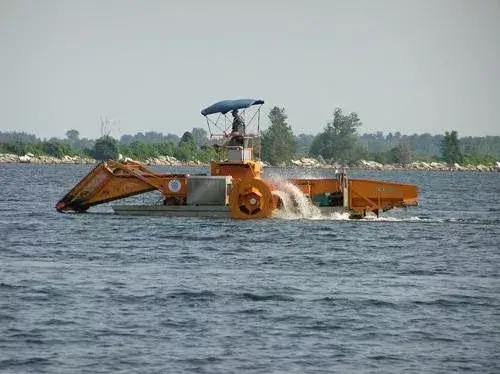
A number of chemicals impact the growth and survival of M. spicatum. Amine salts of Endothall (Hyrothol 191®), and Dipotassium Salts of Endothall (Aquathol K®), Diquat dibromide (Reward®), Komeen® have been found to be effective. Some of these herbicides may also affect other non-target rooted submerged plants, including some rushes. Treatment is most effective in still water in the spring while the plant is actively growing.
The amine formulations of 2,4-D granules (Navigate®, Aquakleen®, Aquacide®) are effective on controlling Eurasian watermilfoil and will not damage most non-target grasses. This herbicide method, however, is not appropriate for large unmanageable areas of milfoil.
One lose-dose application (10 µg/ L) of fluridone (brand names Sonar® and Avast!®) applied in the early stages of growth has the potential to provide season-long control of milfoil. However, this application rate causes collateral damage to native vegetation.
Liquid triclopyr (Renovate 3® and Renovate® OTF) can control milfoil without unintended damage to cattails and grasses.
Note: Always check state/provincial and local regulations for the most up-to-date information regarding permits for control methods. Follow all label instructions. Mention of chemicals, particularly the mention of brand names in this profile does not represent a recommendation by NY Sea Grant or Cornell University.
Since the early-1960s, the grass carp, Ctenopharyngodon idella, has been used to reduce the abundance of invasive and nuisance aquatic plants, including Eurasian watermilfoil, in North America. Unfortunately, in many cases grass carp may only eat Eurasian watermilfoil after native plants have been consumed. Effective control of milfoil therefore means the total removal of native aquatic species the fish find more palatable before the grass carp will consume the targeted Eurasian watermilfoil. This may be acceptable if milfoil is the only aquatic plant species in the lake, but due to the substantial negative impacts on native vegetation, grass carp are generally not recommended for control of Eurasian watermilfoil.
For decades, research has evaluated potential insect and pathogen agents for the biological control of Eurasian watermilfoil. Several species of insects have been identified feeding on Eurasian watermilfoil to a damaging degree in North America. Some of these are species to North America while others may have been introduced accidentally from Europe along with introductions of M. spicatum.
The fungus Mycoleptodiscus terrestris has been shown in laboratory research to reduce the biomass of Eurasian watermilfoil significantly and may serve as a possible biocontrol agent.
The North American herbivorous weevil, Euhrychiopsis lecontie, may be associated with recent natural declines in Eurasian milfoil abundance in some lakes in North America. E. lecontei feeds on new growth M. spicatum and may help keep populations under control without concomitant impact on native species. The native midge Cricoptopus myriophylli (Oliver) are also contenders for this recorded damage to milfoil beds.
As many as 20 species of insects appear to feed on M. spicatum on other continents but do not exhibit the host specificity that would be required to make them candidates for milfoil biocontrol.
Among insect species being studied are the North America native weevil Litodactylus leucogaster (Marsham), which attacks the emersed flower spikes of various milfoil species (including non-target species), and the aquatic midge Cricotopus myriophylli (native from New York to British Columbia). While being implicated in the field for contributing to milfoil reduction in BC, the midge does not appear to contribute significantly to declines in lab experiments.
A promising candidate is the naturalized pyralid moth Acentria ephemerella. A. ephemerella is a generalist herbivore which feeds on a variety of aquatic plants. Field evidence indicates it has been associated with declines in Eurasian watermilfoil populations in Ontario, Canada and in New York. In laboratory and in controlled in lake-enclosure experiments, A. ephemerella reduced biomass and plant height and prevented canopy formation.
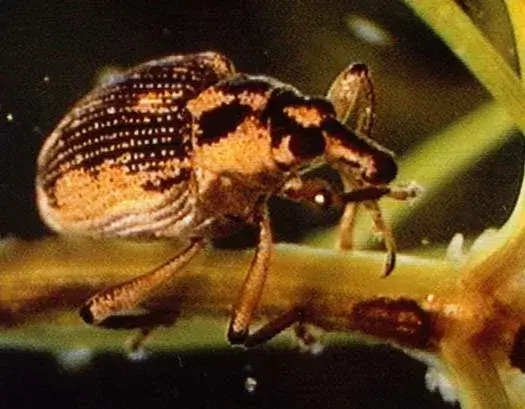
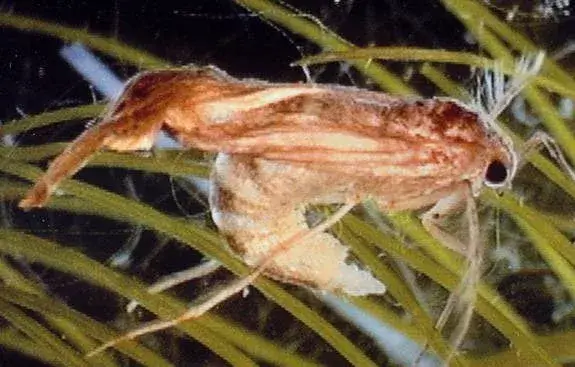
Berg, K. 1942. Contributions to the biology of the aquatic moth Acentropus niveus (Oliver). Vidensk
Medd Dansk Naturh Foren 105: 59-139.
Buckingham, G. R., C. A. Bennett, and B. M. Ross. 1981. Investigations of two insect species for
control of Eurasian watermilfoil. Final Technical Report A-81-4, U.S. Army Corps of Engineers,
Waterways Experiment Station, Vicksburg, Mississippi, USA.
Cofrancesco, Jr., A. F. 1998. Overview and future direction of biological control technology. Journal of
Aquatic Plant Management 36: 49-53.
Couch, R. W. and E. N. Nelson. 1985. Myriophyllum spicatum in North America, pp 8-18. In
Anderson, L. W. J. (ed.). Proceedings of the First International Symposium on the watermilfoil
(Myriophyllum spicatum) and related Haloragaceae species. The Aquatic Plant Management
Society, Washington, D. C.
Crawley, M. J. 1989. The successes and failures of weed biocontrol using insects. Biocontrol News
and Information 10: 213-223.
Creed, R. P. 1998. A biogeographic perspective on Eurasian watermilfoil declines: additional evidence
for the role of herbivorous weevils in promoting declines. Journal of Aquatic Plant Management
36: 16-22.
Creed, R. P., S. P. Sheldon, and D. M. Cheek. 1992. The effect of herbivore feeding on the buoyancy
of Eurasian watermilfoil. Journal of Aquatic Plant Management 30: 75-76.
Denno, R. F., M. S. McClure, and J. M. Ott. 1995. Interspecific interactions in phytophagous insects:
competition reexamined and resurrected. Annual Review of Entomology 40: 297-331.
Furnier, G. R. and M. M. Mustaphi. 1992. Isozyme variation in Minnesota populations of Eurasian
watermilfoil. Aquatic Botany 43: 305-309.
Gleason, H. A. and A. Cronquist. 1991. Manual of Vascular Plants of the Northeastern United States
and Adjacent Canada, 2nd Edition. The New York Botanical Garden. Bronx, NY. 910 pp.
Hairston, Jr., N. G. and R. L. Johnson. 2001. Monitoring and evaluating the impacts of herbivorous
insects on Eurasian watermilfoil. Report to New York State Department of Environmental
Conservation, Division of Fish and Wildlife. Cornell University, Ithaca, New York.
Harris, P. 1981. Stress as a strategy in the biological control of weeds, pp. 333-340. In Papavizas,
G. C. (ed). Biological Control in Crop Production. Allanhead, Osman and Company, Totowa,
New Jersey, USA.
Masters, G.J., V. K. Brown, and A. C. Gange. 1993. Plant mediated interactions between above- and
below ground insect herbivores. Oikos 66: 148-151.
Muenscher, W. C. 1944. Aquatic Plants of the United States. Cornell University Press, Ithaca, New
York, USA.
Nichols, S. A. and S. Mori. 1971. The littoral macrophyte vegetation of Lake Wingra. Wisconsin
Academy of Science, Arts and Letters 59: 107-119.
Reed, C. F. 1977. History and distribution of Eurasian watermilfoil in the United States and Canada.
Phytologia 36: 417-436.
Sheldon, S. P. and L. M. O'Bryan. 1996. Life History of the weevil Euhrychiopsis lecontei, a potential
biological control agent of Eurasian watermilfoil. Entomological News 107:16-22.
Sheppard, A. C. 1945. A new record for Canada (Lepidoptera). Canadian Entomologist 77: 55.
White, D. J., E. Haber, and C. Keddy. 1993. Invasive Plants of Natural Habitats in Canada. Canadian
Wildlife Service, Environment Canada, Ottawa, Ontario.
